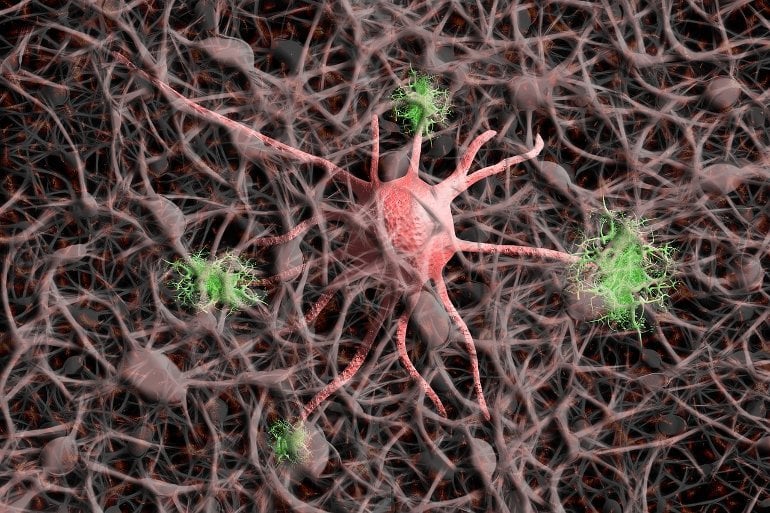Summary: Researchers have released a whole-brain projectome consisting of over 6,000 single neurons in the mouse prefrontal cortex.
Source: Chinese Academy of Science
In a study published in Nature Neuroscience, scientists at the Center for Excellence in Brain Science and Intelligence Technology (CEBSIT) of the Chinese Academy of Sciences, along with their collaborators, reported the first release of a whole-brain projectome comprising over 6,000 single neurons in the mouse prefrontal cortex (PFC), making it the largest database of a whole-brain, single-neuron mouse projectome to date.
The scientists identified 64 projectome-defined neuron subtypes in the mouse PFC and their spatial organization, the modularity and hierarchy of intra-PFC connectivity, and the correspondence between transcriptome-defined and projectome-defined neuron subtypes.
The information flow between different brain regions in the cerebral cortex relies on the long-range axonal projections of neurons. Neurons with different projection patterns are often involved in distinct brain functions.
Therefore, studying the projection patterns of individual neurons is crucial for understanding organization and information processing in the brain. Reconstructing the whole-brain projectome at the single-neuron level can identify new neuron subtypes and uncover wiring rules of the brain network, thus allowing more systematic understanding of how the brain works.
Currently, scientists around the world are working intensively to study the whole-brain projectome at the single-neuron level.
In the brain, the PFC is the center of high-level cognitive function including decision-making, working memory, and attention. Abnormality and malfunction of the PFC can cause many neuropsychiatric diseases.
Axonal projections of the PFC cover nearly all brain areas including the cortex, striatum, thalamus, midbrain, and hindbrain. The axonal projection patterns of neurons in the PFC at the single-cell level are still unclear and the modular organization of the connectivity network within the PFC remains to be uncovered.
Reconstructing the whole-brain projectome at single-cell resolution in mammalian brains is a daunting task and requires continuous tracing of single neurons one-by-one, using large-scale, TB-sized, light microscopic imaging data in 3D. The entire tracing process is labor-intensive, extremely complex, and time-consuming.
To solve this problem, Dr. Gou Lingfeng, a researcher at Dr. Yan Jun’s lab, developed the software package Fast Neurite Tracer (FNT). It facilitated large-scale study of the single-neuron projectome by enabling high-throughput, single-neuron projectome reconstruction and analysis of TB-sized, light microscopic imaging data.
Collaborating with Dr. Xu Ning-long’s lab at CEBSIT, Dr. GONG Hui’s lab at Huazhong University of Science and Technology and many labs at CEBSIT, the researchers reconstructed the complete axon morphology of a total of 6,357 single PFC neurons from the optical imaging data of 161 mouse brains and identified 64 projectome-defined subtypes after quantifying the similarity of axon morphology of different neurons.

Researchers then mapped the spatial distribution of these neuron subtypes in different prefrontal subregions and cortical layers. They analyzed the intra-PFC connectivity network and constructed a high-resolution intra-PFC network, revealing the modular and hierarchical structure within the PFC.
Researchers also performed comparative analysis between transcriptome-defined and projectome-defined neuron subtypes. Using retrograde tracing and single-molecule fluorescence in situ hybridization, they found that each transcriptome-defined subtype corresponds to multiple projectome-defined subtypes.
The study showed that FNT software is efficient for single-neuron tracing in TB-sized image data. It also reconstructed the single-neuron projectome of the mouse PFC and demonstrated a working model of the PFC by studying the internal connectivity and efferent projection patterns of the PFC, thus providing a structural basis for the neural mechanisms of high-level PFC cognitive functions. In these ways, the study lays the foundation for future research on whole-brain mesoscopic connectomes in model organisms.
About this neuroscience research news
Author: Liu Jia
Source: Chinese Academy of Science
Contact: Liu Jia – Chinese Academy of Science
Image: The image is in the public domain
Original Research: Closed access.
“Single-neuron projectome of mouse prefrontal cortex” by Le Gao et al. Nature Neuroscience
Abstract
Single-neuron projectome of mouse prefrontal cortex
Prefrontal cortex (PFC) is the cognitive center that integrates and regulates global brain activity. However, the whole-brain organization of PFC axon projections remains poorly understood.
Using single-neuron reconstruction of 6,357 mouse PFC projection neurons, we identified 64 projectome-defined subtypes.
Each of four previously known major cortico-cortical subnetworks was targeted by a distinct group of PFC subtypes defined by their first-order axon collaterals.
Further analysis unraveled topographic rules of soma distribution within PFC, first-order collateral branch point-dependent target selection and terminal arbor distribution-dependent target subdivision. Furthermore, we obtained a high-precision hierarchical map within PFC and three distinct functionally related PFC modules, each enriched with internal recurrent connectivity.
Finally, we showed that each transcriptome subtype corresponds to multiple projectome subtypes found in different PFC subregions.
Thus, whole-brain single-neuron projectome analysis reveals organization principles of axon projections within and outside PFC and provides the essential basis for elucidating neuronal connectivity underlying diverse PFC functions.






